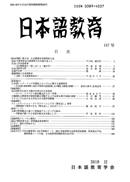Volume 169
Displaying 1-7 of 7 articles from this issue
- |<
- <
- 1
- >
- >|
REGULAR ISSUE
Research Paper
-
2018 Volume 169 Pages 1-15
Published: 2018
Released on J-STAGE: April 26, 2020
Download PDF (2316K) -
2018 Volume 169 Pages 16-30
Published: 2018
Released on J-STAGE: April 26, 2020
Download PDF (2604K) -
2018 Volume 169 Pages 31-45
Published: 2018
Released on J-STAGE: April 26, 2020
Download PDF (2598K)
Survey Article
-
2018 Volume 169 Pages 46-61
Published: 2018
Released on J-STAGE: April 26, 2020
Download PDF (2231K)
Practical Article
-
2018 Volume 169 Pages 62-77
Published: 2018
Released on J-STAGE: April 26, 2020
Download PDF (2421K) -
2018 Volume 169 Pages 78-92
Published: 2018
Released on J-STAGE: April 26, 2020
Download PDF (3276K) -
2018 Volume 169 Pages 93-108
Published: 2018
Released on J-STAGE: April 26, 2020
Download PDF (2365K)
- |<
- <
- 1
- >
- >|
